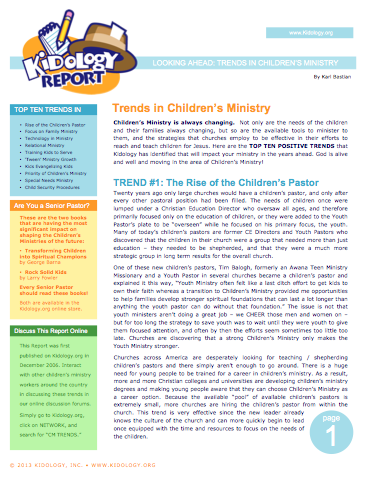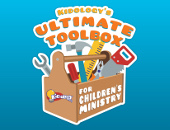Kidology Report: Looking Ahead - Trends in Children's Ministry
Membership Level› Guest
Author/Source: Karl Bastian, the Kidologist
Topic: Children's Ministry Trends
The Kidology Report tackles the "Top 10 Trends in Children's Ministry" that will impact your ministry in the years ahead.
The Kidology Report is a publication that discusses important topics in children's ministry, tapping into the opinions of experienced children's pastors around the country.
While Kidology Professional or Group Members may read it here at Kidology.org, the downloadable printer-friendly PDF document provides you with additional content and features you won't find online.
The Kidology Report is designed to be shared with others in your church with our hope that you will find it another helpful resource as you minister to children.
In this Issue: Looking Ahead: Trends in Children's Ministry
![]() Download Looking Ahead: Trends in Children's Ministry
Download Looking Ahead: Trends in Children's Ministry
(PDF, 1.2M)

Click to download Kidology Report
Looking Ahead: Trends in Children's Ministry
Children's Ministry is always changing. Not only are the needs of the children and their families always changing, but so are the available tools to minister to them, and the strategies that churches employ to be effective in their efforts to reach and teach children for Jesus. Here are the TOP TEN POSITIVE TRENDS that Kidology has identified that will impact your ministry in the years ahead. God is alive and well and moving in the area of Children's Ministry!
TREND #1: The Rise of the Children's Pastor
Twenty years ago only large churches would have a children's pastor, and only after every other pastoral position had been filled. The needs of children once were lumped under a Christian Education Director who oversaw all ages, and therefore primarily focused only on the education of children, or they were added to the Youth Pastor's plate to be "overseen" while he focused on his primary focus, the youth. Many of today's children's pastors are former CE Directors and Youth Pastors who discovered that the children in their church were a group that needed more than just education – they needed to be shepherded, and that they were a much more strategic group in long term results for the overall church.
One of these new children's pastors, Tim Balogh, formerly an Awana Teen Ministry Missionary and a Youth Pastor in several churches, became a children's pastor and explained it this way, "Youth Ministry often felt like a last ditch effort to get kids to own their faith whereas a transition to Children's Ministry provided me opportunities to help families develop stronger spiritual foundations that can last a lot longer than anything the youth pastor can do without that foundation." The issue is not that youth ministers aren't doing a great job – we CHEER those men and women on – but for too long the strategy to save youth was to wait until they were youth to give them focused attention, and often by then the efforts seem sometimes too little too late. Churches are discovering that a strong Children's Ministry only makes the Youth Ministry stronger.
Churches across America are desperately looking for teaching / shepherding children's pastors and there simply aren't enough to go around. There is a huge need for young people to be trained for a career in children's ministry. As a result, more and more Christian colleges and universities are developing children's ministry degrees and making young people aware that they can choose Children's Ministry as a career option. Because the available "pool" of available children's pastors is extremely small, more churches are hiring the children's pastor from within the church. This trend is very effective since the new leader already knows the culture of the church and can more quickly begin to lead once equipped with the time and resources to focus on the needs of the children.
TREND #2: Growing Focus on Family Ministry
Many churches in past decades have made the mistake of thinking the church, or more specifically, the children's pastor (director, coordinator, etc.) can raise kids to know and love God. It simply can't be done. All a children's ministry leader can do is facilitate ministry to better equip families to minister to their kids. As children's pastor Dave Truitt in Mechanicsburg, Pennsylvania, points out, "for years, families have come to church and then went their separate ways as soon as they arrived at church. Then they met at the minivan when it was all over." For years the unspoken mantra of the church has been, "bring your kids to us and we were return them as good Christian boys and girls." It has taken too long for the church to wake up and see that not only was this strategy failing, but it was unbiblical.
Larry Fowler, Vice President of Awana Clubs International and author of the book Rock Solid Kids and Rock Solid Children's Ministry, has been championing the message that the previous strategy of ministry directly and primarily to children has not only been ineffective, but has violated the biblical mandate to equip parents to reach and teach their own children. Awana is one of the global ministries leading the charge to give ministry to children back to parents while at the same time coming alongside parents to help them where they need it. Multiple studies have confirmed that while peers, teachers and others may have some influence on our children's faith and values system, parents have, by far, the most impact - positively or negatively. In his recent book, Transforming Children into Spiritual Champions, George Barna writes, "I have been discouraged to discover that most American adults - including most parents - see the spiritual development of children as a value-added proposition rather than the single, most important aspect of a the child's development."
As the church is waking up to the critical role of parents, they in turn are opening parents' eyes to the need to be more engaged in the spiritual development of their children. We underestimate the power of parents when we think we can do a better job. "A dad stumbling through a prayer is much more effective than an eloquent prayer from the kid's pastor," writes Truitt. There is a movement across the country for children's ministry leaders to recognize that they can no longer ignore the daunting task of involving and engaging parents in the process. It is difficult to be family-focused because, as children's pastor Andrew VanDerLinden notes, "divorced and single parent homes are rampant in today's society and it is the children that are suffering the most. It is hard to be effective in ministry with children that are only able to attend your service once or twice a month because they are with there other parent the other weekends."
But though the task is huge and the obstacles many, the churches that are most effective are finding ways to creatively challenge and engage parents in the children's ministry. The key is to be less program focused, and more focused on relationships. When asked what advice he would give to new children's pastors, Spencer Click, a children's pastor at Crosspointe Life Church in La Mesa, California, answered, "spend as much time as you can nurturing your relationships with parents. Have specific events to help them get to know you – provide them with more information than they need. Do everything you can to get them to "buy" into your ministry." Barna concludes that with the previous strategy of parent-void ministry, "we have virtually lost a generation – we cannot afford to lose another." In response to that, Fowler warns in Rock Solid Kids, "it is not possible to do enough in children's ministry to change the trend. If we are not successful in engaging the home, we will lose another."
TREND #3: Media-Driven Ministry
As in all areas of our culture – the use of technology in ministry is on a growth surge. Marc Romero, the children's pastor at Manassas Assembly of God in Bristow, Virginia, notes, "numerous churches that previously thought video projectors were toys are now investing large amounts of money on getting sharp images on the screens." Todd McKeever, a children's pastor in Fairfax, Virginia, points out that when reaching out to kids, "our use of technology dates our relevance and can attract or disinterest the children we are seeking to reach." Aside from using PowerPoint-driven lessons, wireless mics on puppeteers, and DVDs with on-screen lyrics and backgrounds for worship, the most noticeable trend is DVD-based curriculum. Whereas video clips were once used as teaching elements, there are now several video-based curriculums where children spend a majority of their time looking at a screen and being taught by a pastor they most likely will never meet. Romero aptly notes that "kids have learned their ABCs with Big Bird, manners with Mr. Rogers, and humor from SpongeBob. There is a HUGE potential to use media as a resource for teaching Truth in the church." He quickly adds, however, that "media can be a great addition to the successful things you are already doing, but as with any medium used in a children's service, media should be viewed as a tool and not a solution."
DVD curriculum was born in part out of the rapid growth of ministries such as Saddleback Community Church and the need to ensure that the same message was being taught with uniform quality throughout the many classrooms. Saddleback's children's pastor Craig Jutila's DVD-based curriculum (empoweringkids.net) uses media for the teaching segment and several other components, but still provides materials for relational ministry to take place in small group discussions with men and women who know the children personally.
Another highly popular DVD curriculum that promotes itself as the "reinvention of Sunday School" is Kidmo (kidmo.com), which is almost entirely video-driven and needs only an Emcee up front as a guide. While there is a place for DVD curriculum especially for small churches or ministries struggling with adequate volunteers, there is a danger in this trend. Larry Shallenberger, Pastor of Children and Student Ministries, at Grace Church, Erie, Pennsylvania, cautions that "many of these curriculums are imbalanced and there is a concern that students become passive learners." Romero admits "DVD curriculum makes me a little nervous, especially when churches are deciding to purchase a DVD to teach kids instead of investing in a Children's Pastor who will shepherd them. Will a DVD curriculum truly prepare kids to be a lifetime Christian?" There is certainly a need to help equip volunteers and a desire to make their job as easy as possible, but Children's Pastor Spencer Click isn't so sure it is a good thing as he laments that there has been "too strong a move towards overly 'Teacher Friendly' or 'Plug and Play' curriculums. Too many children's pastors are seeking a curriculum that can be done with almost no prep work. Do we really want a curriculum that is a microwave meal?" Technology is a reality we can't ignore and should harness to be as effective as possible, but at the same time, we need to keep in mind that Jesus was pretty effective with nothing that plugged into an outlet. Ministry will always be about relationships. Interestingly, many small churches that can't afford much in technology still are growing and reaching kids. Perhaps they have more time for relationships with less gadgets to plug in?
TREND #4: Growing Emphasis on Relational Ministry
"Relationship connection is the currency of kids. You can buy the right to their attention, buy the right to be heard, and buy the right to get a response from them." So states Jamie Doyle, the Children's Pastor at Radiant Life Church, in Colorado Springs, a church that has grown nearly 50% this past year. Technology and programs will never replace the power of relationships. Growing children's ministries are making sure that in the midst of all the programming, there is room for relationships with kids. Children's Pastor Spencer Click adds, "this has become especially important with the older kids (5th & 6th Graders). They have been entertained to death; they have been patronized with puppets longer than anyone cares to admit." They need to know that somebody with a name and a face knows them and cares about them. If no one on earth really cares, how can they ever believe that God does?
There is an old saying that goes "they don't care how much you know until they know how much you care". Scott Phillips, the Children's Church Director at Tabernacle Church in Laurel, Maryland, reminds us that "this truth is essential in children ministry. The things our children are facing today are not the same things children faced thirty years ago. We must be aware of the challenges they are facing in life in order to be able to steer them to make the right choices." It is conversation, not videos or games, that draw out the inner struggles and needs of children. It is only through relationships that people are genuinely impacted and then changed. In children's ministry, we too often get caught up in trying to impress kids (or their parents) with the ministry feats we can pull off, but in the end, it is only relationships that matter. As Karl Bastian likes to say, "A video can't love a child." Relationships will always be most effective.
When asked what was one of the ministry highlights of his year, Pastor Todd McKeever wrote about an experience with a little seven-year-old girl who was dying. As people were visiting her someone asked her to talk about some of her greatest memories. Her response was, "I miss and enjoy the most when Pastor Todd laughs in kids church." She didn't mention the giant inflatables or games or any of the programs at Jubilee Christian Center, instead, she fondly remembered the laugh of her children's pastor. A hearty laugh will out-minister a video projector any day of the week.
TREND #5: Kids Being Trained to Serve
The age of children as mere spectators is over. The result of having kids sit and 'watch' church has resulted in a generation of youth and even adults who expect to come to church to 'get' instead of 'give.' It is of little wonder that so many adults are oblivious to the need to serve – we raised them to be spectators once they enter the building. Fortunately, that is changing. "One of the positive trends in the current generation in children's ministries is the desire to be very 'hands-on.' Children want to feel involved and a part of what is going on; they desire physical participation not just visual stimulus," writes Children's Pastor Spencer Click. Not only is ministry more effective when kids are serving, they are learning as well. Children's Pastor Dave Truitt writes, "kids of today are more interested in doing than learning – but by doing, they are learning. Training kids to serve helps them take their eyes off of themselves and onto others." The best way to reverse the trend of losing children in the teenage years is to engage them before those turbulent years come. George Barna adds extra urgency to the need to train children when he states that "social scientists have known for years that the moral foundations of children are generally determined by the time the individual reaches age nine... Anyone who wishes to have a significant influence on a person's moral and spiritual foundations had better exert that influence while the person is still open-minded and impressionable - in other words, while the person is young." For children who find serving at church natural, it will become a life long habit. When we engage kids, Click points out they "are transformed from 'sitters' in to 'doers.'" Paul Bradford, a CE Director in Coudersport, Pennsylvania, notes that plugging in kids now helps keep them stay engaged in the church later because "some kids leave church as a teenager because they feel if they left no one would even notice." Training kids to serve transforms 'making disciples' from mere words to action.
TREND #6: Increased Attention to "Tween" Ministry
George Barna's research (barna.org) concludes that "more often than not, what a person decides about truth, sin, forgiveness and eternal consequences during their pre-teen years is the same perspective they carry with them to their grave - and beyond, where ever that may take them." Pastor Marc Romero commented on this when he wrote, "tweens are a growing force in our economy and culture. Churches are starting to realize that this new group requires specialized focus. Tweens are the Junior Highers of the 80's and 90's."
According to a UNC Chapel Hill study by Southern Baptist Convention, "after high school seniors, tweens are the second largest group of people to leave the church and never come back." Even secular sources are expressing concern over how fast our children are growing up. A recent AP article noted that children as young as fifth and sixth graders are developing teen attitudes, including disrespect of parents/authority as well as interest in dating and consumerism. Joni Lum, a children's ministry leader in Irvine, California, commented that "the chasm between our younger and older elementary children seems to be widening and thus we need to continually pray and look for ways to engage and stimulate our tweens to help them live out their Christian faith."
Ministries with names such as 'Club 56' are cropping up all over the nation. While the focus on tween ministry is a healthy trend, it is not as simple as treating preteen ministry as a mini or early youth ministry. Too often churches are jumping to combine middle school ages that developmentally are not best mixed. The trend with public middle schools to include preteens with junior highers is often more space / capacity motivated rather than developmental or educational strategy. Before a church moves too quickly to combine preteen and junior high it is advised to inquire what the middle schools in their area are doing within the buildings. Most often it will be discovered that the preteens and junior highers are completely separated. There is another danger with tween ministry when a church provides all the "youth ministry ideas and strategies" to preteens. The kids will certainly have a lot of fun, but the gap from 5th grade to 12th is extremely wide and too often youth ministries struggle with little left to offer their older teens if preteen and junior high ministry have stolen the thunder. But with these cautions, the trend to target tweens and seek to effectively engage and minister to them is positive and critical.
TREND #7: Kids Evangelizing Kids
Another healthy trend is the increased focus, and with it, improved resources to equip children to share their faith with their friends. Kids reaching kids will always be one of the most effective strategies for reaching kids for Christ. Joni Lum points out that including kids in outreach helps to "reinforce Jesus' teaching that children are important, their gifts are real, and they can be an integral part of fulfilling the great commission now, not ten years from now." Who has the most access to children in neighborhoods and pubic schools? Other kids who already know God. Spencer Click notes that "this is the most vital way to either grow your church or the kingdom of God as a whole. Feedback from other children's pastors has confirmed a universal truth, the most effective way to get new kids to church is through a friend." (For helpful resources, take a look at evangecube.org or cefonline.com). Growing children's ministries are growing in part because they are training their kids to reach their friends.
TREND #8: Prioritization of Children's Ministry
Children's Pastor Jamie Doyle rejoices that "George Barna's Book, Transforming Children into Spiritual Champions, is taking hold of senior pastors in America. It's making them think about securing the future of the church." No longer is children's ministry's purpose seen as occupying the children while real ministry takes place elsewhere. Churches are catching the vision that if you want to grow, the most effective means is through reaching families through their children. As Larry Shallenberger notes, "children's ministry had been viewed as essential to capturing boomers in the '80's and '90's. However, the next step is beginning to occur: Children's Ministry is being valued as a way to advance the mission of the church." The most obvious way this trend is seen, after the hiring of a children's pastor, is that the children's ministry area of the church is often transformed. Andrew VanDerLinden points out that "before you can touch the heart and lives of children you must capture their eyes and ears. Each time you improve your facility to make it more kid friendly you become more effective in reaching young families and children. We live in a day that parents will attend a church that they don't particularly enjoy or like, if the needs of their children are being met."
While we can wring our hands over the commercialism that has families 'church shopping' the reality is if we want to draw kids and their families, we need kid-friendly environments. Marc Romero says it this way: "No longer satisfied with drab walls and dull carpets, churches are remodeling their children's environments to be fun and inviting. Children's ministries are doing everything from repainting walls to installing slides and arcades. Churches are waking up to the fact that what a child experiences in their first ten minutes of walking into their building will give the parents their first impression about how a church views the importance of kids."
But as with all positive trends, there is a warning. Environment may draw families and help engage kids initially, but it is still truth communicated through loving relationships that transforms hearts. A church that can't remodel their children's ministry can still be more effective than a church that looks like an area in Disneyland if relational ministry is not taking place within the programming. Whether it results in multi-million dollar remodeling, or simple murals, or better budgeting, or hiring staff to focus on children, a priority on children's ministry throughout the church can only help build the Kingdom of God through reaching and teaching kids.
TREND #9: Ministry to Children with Special Needs
One encouraging trend is that many churches are moving away from cookie cutter approaches to ministering to children, and that includes acknowledging that many kids come with special needs that need individual focused attention. In the past, children who struggled to succeed in the regular classes or programs either stopped coming, were considered as discipline problems, or were gathered into a special classroom so as not to disturb the other children. Healthy churches today are not ignoring the growing reality of children with special needs and are creatively seeking ways to minister to the whole family. Most often churches develop a "Friends" or "Buddies" ministry where children with special needs can have a dedicated volunteer to assist them through the regular programming. Churches are helping families take better responsibility for their child's unique needs and providing helpful resources and attention so that they can help their child get the most out of their church experience.
TREND #10: Increased Attention to Child Security
When people think of a children's pastor, often the image that comes to mind is that of a teacher with a puppet on one hand, an object lesson in the other, and a guitar strapped to their back. What most people don't realize is that today's children's pastor is often a family counselor, a savvy administrator, a staff manager, a book keeper, a pharmacist (educated in the behavior drugs kids are taking), as well as a lawyer and safety monitor. It is no longer just the mega-churches that have to focus on volunteer screening and child security issues. As other secular programs are clamping down on child safety issues, unfortunately the church has become one of the last places a predator can turn to get fast easy access to children! Jamie Doyle notes that in the years ahead "churches will need to – and be forced to – implement security plans to make the church a safe environment for the entire family. They need to consider secure check-in systems, separate children's ministry wings in buildings that have monitored entrances and exits." Some churches are now using hall monitors, security guards or even uniformed police on site. Once considered an extreme measure, background checks are an assumption in most churches today. (Recommended resource for background checks: kidcheck.com)
With Kids in Mind... Karl's Final Thoughts
Many who read this report I hope will be challenged to give some new or renewed focus to some of the areas covered. However, I would like to conclude this report by encouraging you not to try to address all of these at once. These trends are presented for prayerful reflection, not as a checklist for your ministry. Beware of the difference between trends and fads. As Dick Gruber once wrote, "a trend can serve to guide your children's ministry, or it can drive it into the ground." Each of these trends, if reflected in your ministry, can have a positive influence on your mission to reach and teach children (and their families) for Jesus. But in the end, we sometimes need to be reminded that it is not the 'stuff' of ministry that changes the lives of kids. It is not our programs, props, puppets, or projectors that get into the hearts of children – it is only an encounter with the Love of God for each and every one of them. I love the story of a young boy over a century ago who was walking through the snowy cold streets of Chicago on his way to Mr. Moody's Sunday School. Another Sunday School teacher stopped him and invited him to attend his Sunday School which was much closer, but the boy responded that he'd rather go to Mr. Moody's Sunday School. When asked why he would travel so far across the city to go to another church when the one being offered was much closer, the boy replied, "because at Mr. Moody's Sunday School, they really know how to love a kid." Trends come and go, but God's love is here to stay. Make sure loving kids is the #1 trend in your children's ministry!
Permission is granted to reprint the Kidology Report as needed for distribution in your local church or ministry











